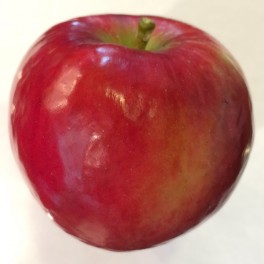Dayton Apple
The Dayton apple is great tasting disease resistant sweet/tart apple.
Excellent for: Fresh eating; Sauce
ID-21A
More info
An excerpt from HortScience, October 1988:
'Dayton' Apple
'Dayton' is an attractive red apple (Malus x domestica Borkh.) with field immunity to apple scab incited by Venturia inaequalis (Cke) Wint. This apple is named in honor of Daniel F. Dayton, Emeritus Professor and longtime leader of the disease-resistance apple breeding program at the Univ. of Illinois.
'Dayton' is the seventh apple cultivar (1-6) developed by the cooperative apple breeding program of the Illinois, Indiana, and New Jersey Agricultural Experiment Stations. The fruit is large, an attractive glossy red (Fig. 1), and matures with 'Prima' and 4 weeks before 'Delicious'. Fruit is well distributed over the tree and hangs for almost 2 weeks without loosing its firmness and dessert quality. It retains its good flavor and firm flesh up to 4 weeks in cold storage (1°C). 'Dayton' is released as a potential commercial cultivar for use as a summer dessert apple; in addition, it makes an excellent backyard apple.
Origin
The original seedling was planted in 1969 in a breeding orchard of the Illinois Experiment Station, Urbana, Ill. The seedling resulted from crossing a New Jersey selection, NJ 123249 as pollen parent, with an earlier scab-immune seedling selection, PRI 1235100, as seed parent. The complete pedigree is shown in Fig. 2. The seedling was selected on the basis of pomological characteristics in 1976. Propagated trees have been under test as Co-op 21 at cooperating experiment stations in several states and in other countries.
Description
The new cultivar produces a moderately upright tree similar to 'Delicious'. The fruit is attractive and has a very good, full-flavored dessert quality. The flesh is pale yellow, crisp, juicy, fine grained, and mildly sub-acid.
'Dayton' carries the Vf gene for resistance to apple scab derived from M. floribunda 821 and has shown resistance to the five races of the organism in greenhouse inoculations and field immunity during 12 years of testing in Illinois, Indiana, New Jersey, Oregon, and at various research stations in Canada and Europe. In addition, 'Dayton' has moderate resistance to powdery mildew, incited by Podosphaera leucotricha (Ell. & Ev.) Salm and to fire blight incited by Erwinia amylovora (Burr.) Winslow et al.
The following detailed description follows Zielinski (7) and uses color designations according to the Royal Horticultural Society Colour Chart, issued by the Royal Horticultural Society of London.
FLOWER
- Pedicel: 17-21 mm long.
- Corolla: 37-40 mm fully expanded.
- Color: tight bud-pink, plate 52C; open-pale pink, plate 56D.
FRUIT
- Shape: roundish to slightly oblate.
- Size: axial diameter, 65 mm; transverse diameter. 74 mm.
- Color: bright medium red (plates 46C to 46B, covering up to 90% of the fruit surface.
- Skin: smooth and very glossy, light tan dots widely spaced but numerous near apex; thin, moderately tough.
- Stem: 18-21 mm in length, medium in thickness and medium stiffness.
- Cavity: acute, deep, medium, russeted.
- Basin: medium depth and breadth with lobes on inner sloping sides.
- Calyx: persistent, covergent, partly to fully closed.
- Calyx tube: vase shaped.
- Stamens: medium.
- Core Line: meeting.
- Core: medium, closed, small.
- Carpels: mucronate, elongated, not tufted.
- Seed: acute, nontufted.
- Flesh:
- Texture-fine grained, firm, crisp;
- Quality-very good, subacid to mild, flavor resembles 'Prima' but less acid; 13.3% soluble solids and 0.3% titrable acid contents;
- Color-pale yellow (plate IID).
- Maturity season: 4 weeks before 'Delicious'.
- Keeping quality: retains quality up to 4 weeks at l°C.
TREE
- Tree: moderately upright and vigorous.
- Foliage: ovate with single serrate margin glabrous, not rugose, apex acuminate: base obtuse, length to width ratio = 1.5.




